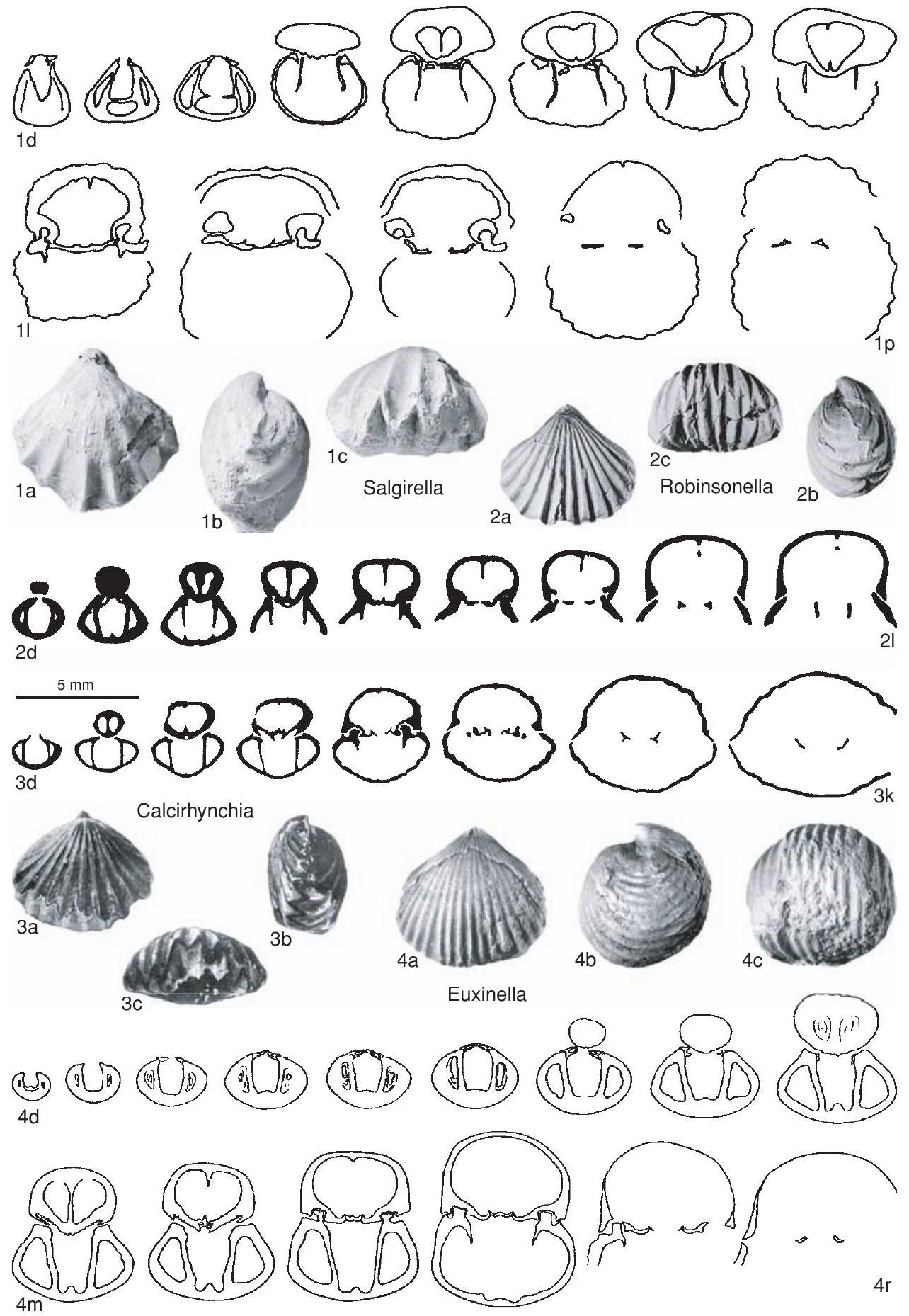Welcome to the Treatise on Invertebrate Paleontology!
Please enter a genera name to retrieve more information.

Robinsonella
Classification
Phylum:
Brachiopoda
Subphylum:
Rhynchonelliformea
Class:
Rhynchonellata
Order:
Rhynchonellida
Superfamily:
Wellerelloidea
Family:
Wellerellidae
Subfamily:
Cirpinae
Formal Genus Name and Reference:
Robinsonella MOISEEV, 1936, p. 45
Type Species:
R. mastakanensis, OD
Images
(Click to enlarge in a new window)
Fig. 862, 2a-l. *R. mastakanensis, Rhaetian, northwestern Caucasus, a-c, holotype, dorsal, lateral, anterior views, TsGM 55/4801, x1, d-l, transverse serial sections, distances in mm from first section, 0.6, 1.0, 1.5, 1.8, 2.1, 2.5, 3.0, 3.8, 4.3 (Dagys, 1963).
Synonyms
Geographic Distribution
northwestern Caucasus, India, China, Vietnam, Japan, ?New Guinea
Age Range
Beginning Stage in Treatise Usage:
Upper Triassic (Norian)
Beginning International Stage:
Norian
Fraction Up In Beginning Stage:
0
Beginning Date:
227.3
Ending Stage in Treatise Usage:
Upper Triassic (Rhaetian)
Ending International Stage:
Rhaetian
Fraction Up In Ending Stage:
100
Ending Date:
201.36
Description
Small, subpentagonal, moderately biconvex, strongly costate, with distinct sinus and feeble corresponding fold, beak short, incurved, ridges rounded, foramen hypothyrid, deltidial plates double, conjunct. Dental plates subparallel, no pedicle collar, septum distinct, about one-third valve length, hinge plate horizontal in section, crura allegedly hamiform. Alternatively, may be related to ivanoviellines (hinted by development of ribbing, dorsal septum, and pitlike septalium), further studies of crura needed.
References
Museum or Author Information
Classification
Phylum:
Brachiopoda
Subphylum:
Rhynchonelliformea
Class:
Rhynchonellata
Order:
Rhynchonellida
Superfamily:
Wellerelloidea
Family:
Wellerellidae
Subfamily:
Cirpinae
Formal Genus Name and Reference:
Robinsonella MOISEEV, 1936, p. 45
Type Species:
R. mastakanensis, OD
Images
(Click to enlarge in a new window)
Fig. 862, 2a-l. *R. mastakanensis, Rhaetian, northwestern Caucasus, a-c, holotype, dorsal, lateral, anterior views, TsGM 55/4801, x1, d-l, transverse serial sections, distances in mm from first section, 0.6, 1.0, 1.5, 1.8, 2.1, 2.5, 3.0, 3.8, 4.3 (Dagys, 1963).
Synonyms
Geographic Distribution
northwestern Caucasus, India, China, Vietnam, Japan, ?New Guinea
Age Range
Beginning Stage in Treatise Usage:
Upper Triassic (Norian)
Beginning International Stage:
Norian
Fraction Up In Beginning Stage:
0
Beginning Date:
227.3
Ending Stage in Treatise Usage:
Upper Triassic (Rhaetian)
Ending International Stage:
Rhaetian
Fraction Up In Ending Stage:
100
Ending Date:
201.36
Description
Small, subpentagonal, moderately biconvex, strongly costate, with distinct sinus and feeble corresponding fold, beak short, incurved, ridges rounded, foramen hypothyrid, deltidial plates double, conjunct. Dental plates subparallel, no pedicle collar, septum distinct, about one-third valve length, hinge plate horizontal in section, crura allegedly hamiform. Alternatively, may be related to ivanoviellines (hinted by development of ribbing, dorsal septum, and pitlike septalium), further studies of crura needed.
